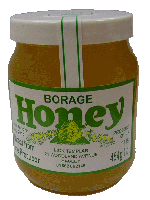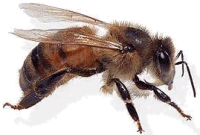PRODUCTS OF THE BEE COLONY
Honey
The composition of honey depends on the type of bee, the plants from which the nectar was gathered, the soil on which they grew and the weather.

Honey is composed mainly from two types of sugar, glucose and fructose, which account for 70% of its content. Other types of sugar account for a further 10% and the rest is water with very small amounts of acids, enzymes and minerals such as potassium, sodium, calcium and magnesium.
Honey is a source of instant energy; its sugars are more easily assimilated by the body than white sugar because they have already been partially digested by bees. Frequent references are made in ancient texts to the value of honey for medicinal purposes, as it has long been known to have antiseptic and antibiotic properties. Recent studies have shown that the rate of post-operative healing of open wounds and the formation of scar tissue increases dramatically when honey is used on dressings.
Royal jelly
Royal jelly is a milky liquid made by bees to nourish all new larvae for the first 2-3 days of their life. After this period the worker bees are fed on pollen-based nutrient and royal jelly is reserved exclusively to feed future queens, hence its name.
Royal jelly is collected by cutting away the capping from queen cells, removing the larvae and scooping out the contents of the cells. At least 100 queen cells are needed to produce one ounce of Royal jelly, therefore it is very expensive. It is said to improve resistance against illness or infection if taken internally, and is believes by some to slow down the ageing process. Although Royal jelly is certainly not harmful, there is no real evidence of its medicinal value.
Propolis
Propolis is a resinous substance excreted by certain plants and is used by bees to seal up and protect their hive or any hollow nesting place they may occupy. It contains natural antibiotics that protect the colony, fighting off diseases and bacterial and fungal growth.

Propolis is known to have some healing properties and is used by practitioners in alternative medicine as a surgical antiseptic.
Propolis-based products such as herbal elixir, ointment and toothpaste are said to help throat infections, gum disorders and skin complaints.
Pollen
Pollen is the living male sex cell of plants and trees that enables bees to pollinate plants as they forage. Bees also use pollen to make brood food for larvae and young bees.
Pollen collected from hives is packaged as dried pollen granules and is sold in health food shops as a food supplement containing proteins, minerals, vitamins, enzymes and carbohydrates. It is believed to provide protection against hay fever, particularly if it has been collected by the bees from the plant sources that cause the symptoms in the sufferer.
Wax

Wax is secreted from the wax glands of young bees as long as they are able to feed continually on nectar, honey or a syrup substitute provided by the beekeeper. As soon as the food supply is interrupted the wax glands shrink and will not recover, even after feeding is resumed.
The bees use wax to build a series of vertical combs made of hexagonal cells. Although the wax in the cells is very thin, its structure gives it such strength that a piece of comb measuring 10cm. by 5cm. can hold a pound of honey.
The cells are used to raise young brood or to store pollen and honey for use at times when the bees are unable to gather food from outside.
